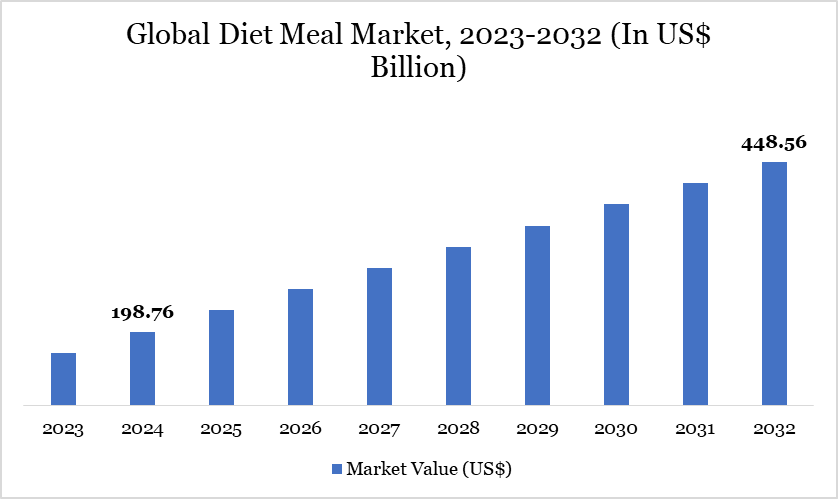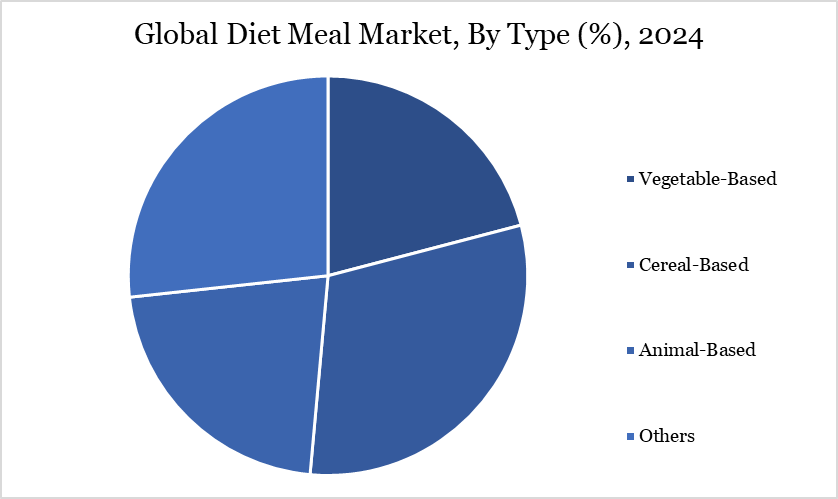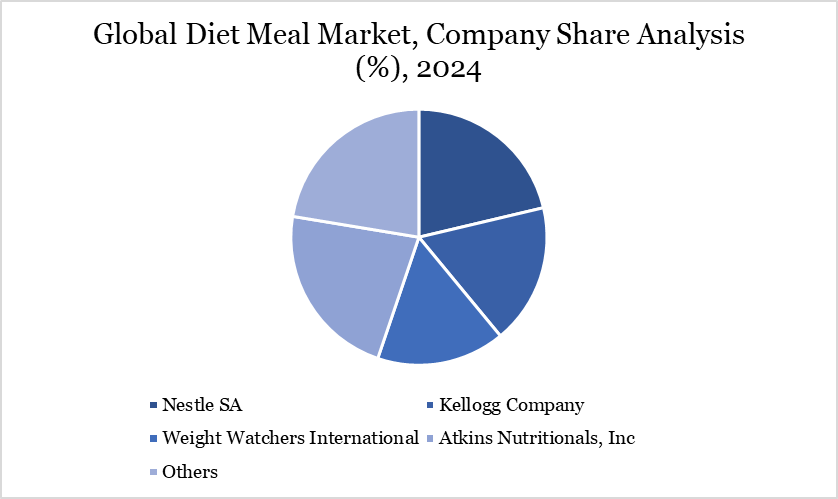Diet Meal Market Size
Diet Meal Market Size reached US$ 198.76 billion in 2024 and is expected to reach US$ 448.56 billion by 2032, growing with a CAGR of 10.71% during the forecast period 2025-2032.
The global diet meals market is growing rapidly as there is a shift in consumer preference towards convenient, health-focused meals. This is because a growing number of consumers recognize the importance of nutrition in availing healthcare services without falling ill in the first place, hence, the appeal for skinny meals, which are low in calories, low in carbohydrates, but with healthy proteins.
Furthermore, policies such as the USFDA, EFSA and others, which are promoting standards of food quality control and improving food safety and disclosure of nutritional information, are fueling the market demand. The policy guidelines assist in averting the situation where it offers diet meal products that are unconfirmed to the accepted diet standards and nutritional requirements, hence enhancing the confidence of the buyers and aiding the growth of the market.
Diet Meal Market Trend
The growing emphasis on high-protein diets is a key trend in the diet meals market as consumers increasingly prioritize muscle health, metabolism, and satiety. Protein-rich meals, from both animal and plant sources, are being favored for their role in weight management and sustained energy. This shift is especially prominent among fitness enthusiasts and health-conscious individuals seeking convenient yet nutritious meal options. Food brands are responding with innovative, protein-enriched products such as shakes, snacks, and ready meals tailored to this demand.
Government initiatives are also driving the diet meals market across Asia. In China, the government is promoting a healthy diet under its 2030 health goals to curb rising obesity, creating strong demand for balanced, low-calorie meals. Similarly, in India, the National Health Mission (NHM) emphasizes preventive healthcare through diet, especially with rising diabetes and heart disease cases. This policy direction has accelerated the market for diet-specific and health-targeted foods, reinforcing a broader shift toward proactive, nutrition-led wellness.

For more details on this report – Request for Sample
Market Scope
Metrics | Details |
By Product | Beverages, Supplements, Snacks, Others |
By Type | Vegetable-Based, Cereal-Based, Animal-Based, Others |
By Packaging | Canned, Retort, Others |
By Distribution Channel | Hypermarket and Supermarket, Specialty Stores, Convenience Stores, E-Commerce, Others |
By Region | North America, South America, Europe, Asia-Pacific, Middle East and Africa |
Report Insights Covered | Competitive Landscape Analysis, Company Profile Analysis, Market Size, Share, Growth |
Diet Meal Market Dynamics
Increasing Focus on Weight Management and Body Wellness
The rising global emphasis on weight management and body wellness is significantly fueling the growth of the diet meal market. In an era where physical appearance, energy levels, and long-term health are closely linked to body weight, consumers are increasingly adopting structured dietary plans. Diet meals, which offer portion control, calorie regulation, and balanced nutrition, are becoming a preferred solution for those aiming to lose weight or maintain a healthy lifestyle. The demand is particularly high among urban populations and working professionals seeking convenient yet health-conscious food options.
In 2024, the NCD Risk Factor Collaboration (NCD-RisC) published findings estimating that more than one billion people globally are living with obesity, including nearly 880 million adults and 159 million children and adolescents aged 5–19. The World Obesity Federation’s analysis further reveals that almost 3 billion people are living with either overweight or obesity. With most of the world's population now living in countries where overweight and obesity pose a greater health risk than undernutrition, the diet meal market is well-positioned to respond to growing consumer demand for practical, health-forward solutions.
Workforce Shortages and Supply Chain Challenges
The lack of people working in the food service industry and the inflation of the supply chain hamper the global diet meal market. The unemployment in this sector has made it impossible to satisfy US Bureau of Labor Statistics (BLS) expectations that by 2030, employment in food preparation and serving-related occupations will have risen by 12%. As a result, the range of food products including diet meals, has suffered delays in production and distribution.
The ongoing geo-political events such as war and pandemics, are an upsurge in the availability of materials like cereals, greens and meats. Thus, this war has played a significant role in creating a lack of some food products and increased prices for the available ones, especially in the production of diet meals. This situation has created barriers in terms of supply and pricing of diet meals in most of the countries in Europe, where there is a high dependence on imported diet ingredients.
Diet Meal Market Segment Analysis
The global diet meal market is segmented based on product, type, packaging, distribution channel and region.

High Demand for Cereal-Based Food
The rising prevalence of health issues such as obesity and diabetes across the globe has led to a gradual increase in the need for these dietary packages to be low-calorie yet filled with protein-rich foods. The World Health Organization (WHO) reported that in 2022, 2.5 billion adults aged 18 years and older were considered to be overweight, one of them being over 890 million adults who were obese and which also adds to the context of the diet meals. Mounsey and Barnsley (2021) observe that in addition to general weight loss programs, specific meals such as carel based meal plans are gaining more preference.
Whole grain-based foods, as well as protein blend even fortifies those foods, are gaining acceptance among health seekers. Most of these meals are also centered around other ingredients such as whole maize, lentils and millet which not only help to achieve the desired dietary requirements but also help to enrich the protein content of the meal. With an increased awareness of health complications emanating from obesity and diabetes, the market for high-protein cereals and cereal-based meals has changed significantly.
Diet Meal Market Geographical Share
High Prevalence of Lifestyle Diseases and Strong Consumer Awareness in North America
North America holds a significant share in the global diet meals market due to the high prevalence of lifestyle-related diseases and a strong consumer focus on health and wellness. According to the CDC, around 42% of US adults are overweight or obese, highlighting a growing need for tailored dietary solutions. The region benefits from a highly developed food processing industry, making it easier to offer specialized meals that align with various health conditions and dietary needs. Additionally, increased healthcare spending—reaching $4.5 trillion in 2022 according to CMS reflects growing investment in health management, including preventive nutrition strategies like diet meals.
Government support further strengthens market demand through initiatives like the USDA’s dietary guidelines, promoting healthier eating habits. These policies encourage the development and consumption of nutrient-specific foods. Moreover, the rise of controlled diet meal delivery services appeals to time-constrained but health-conscious consumers, making healthy eating more accessible. The convergence of obesity concerns, health policy, food technology, and consumer behavior positions North America as a dominant force in the global diet meals market.
Sustainability Analysis
Sustainability is increasingly influencing the global diet meals market, as companies prioritize eco-friendly ingredients and biodegradable packaging. The Global Sustainability Council for Food and Agriculture Council notes that the diet meals sector can also help achieve environmental objectives when sourcing mainly plant- and fungi-derived products which are usually less carbon-intensive than animal-sourced. This shift aligns with a growing consumer demand for environmentally-conscious products, prompting businesses to adopt sustainable practices actively.
In addition to this, diet meals that make use of seasonal produce help in addition to bringing down the carbon footprint associated with the transportation of goods. As the level of consciousness towards the environment increases, the movement directed towards the adoption of sustainable practices in the diet meals industry is likely to continue. It is not only that consumers' preferences are being catered to but also active measures are being undertaken to improve sustainability.
Diet Meal Market Major Players
The major global players in the market include Nestle SA, Atkins Nutritionals, Inc., Herbalife Ltd., Nutrisystem Ltd., Kellogg Company, Olympus Corporation, Weight Watchers International, Jenny Craig, The Gold’s Gym International, and HAPPY OJO LIFESTYLE PRIVATE LIMITED.

Key Developments
On 14 June 2024, the World Health Organization (WHO) released new guidelines recommending fiscal policies to promote healthy diets. These policies aim to discourage consumption of unhealthy, highly processed foods high in fats, sugars, and sodium, while encouraging healthier food choices through subsidies and support. The guidelines address the global challenge of unhealthy food environments, which contribute significantly to noncommunicable diseases like obesity, diabetes, and heart disease.
In March 2023, Nestlé made a strategic investment in Munich-based YFood, a start-up specializing in meal replacements. YFood offers a range of products, including meal-replacement drinks, powders and snack bars aimed at consumers looking for easy, balanced nutrition on the go.
Why Choose DataM?
Data-Driven Insights: Dive into detailed analyses with granular insights such as pricing, market shares and value chain evaluations, enriched by interviews with industry leaders and disruptors.
Post-Purchase Support and Expert Analyst Consultations: As a valued client, gain direct access to our expert analysts for personalized advice and strategic guidance, tailored to your specific needs and challenges.
White Papers and Case Studies: Benefit quarterly from our in-depth studies related to your purchased titles, tailored to refine your operational and marketing strategies for maximum impact.
Annual Updates on Purchased Reports: As an existing customer, enjoy the privilege of annual updates to your reports, ensuring you stay abreast of the latest market insights and technological advancements. Terms and conditions apply.
Specialized Focus on Emerging Markets: DataM differentiates itself by delivering in-depth, specialized insights specifically for emerging markets, rather than offering generalized geographic overviews. This approach equips our clients with a nuanced understanding and actionable intelligence that are essential for navigating and succeeding in high-growth regions.
Value of DataM Reports: Our reports offer specialized insights tailored to the latest trends and specific business inquiries. This personalized approach provides a deeper, strategic perspective, ensuring you receive the precise information necessary to make informed decisions. These insights complement and go beyond what is typically available in generic databases.
Target Audience 2024
Manufacturers/ Buyers
Industry Investors/Investment Bankers
Research Professionals
Emerging Companies